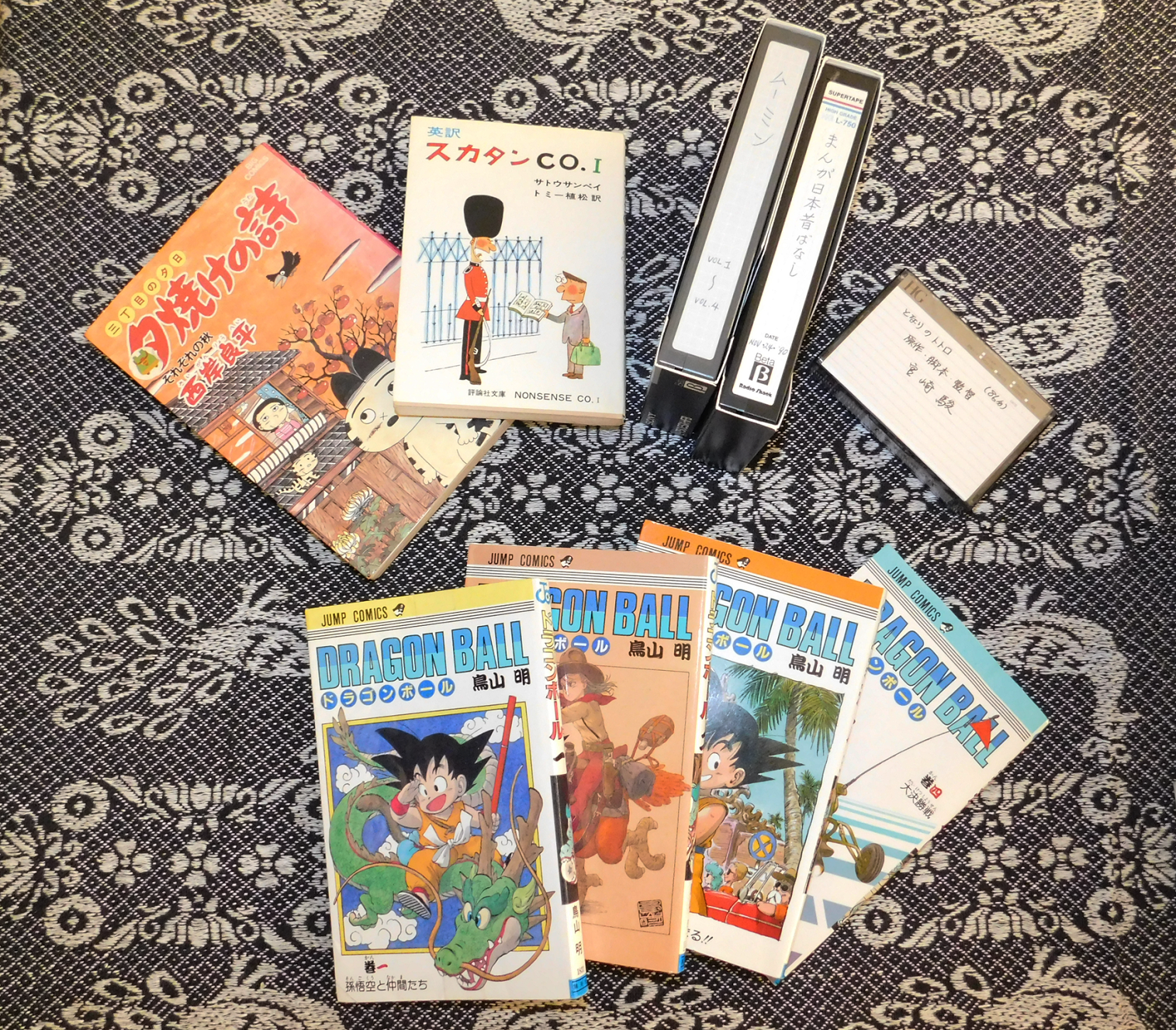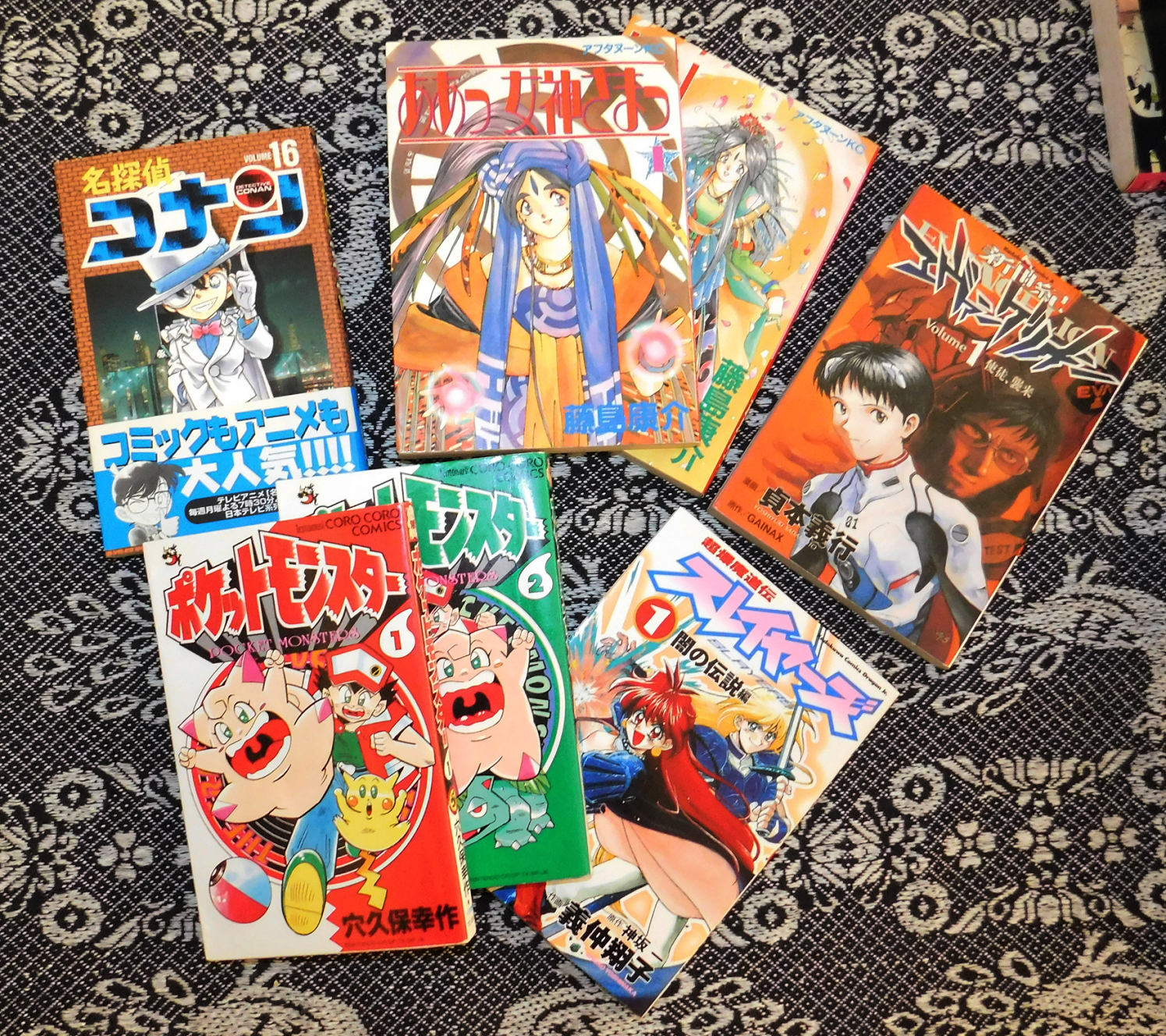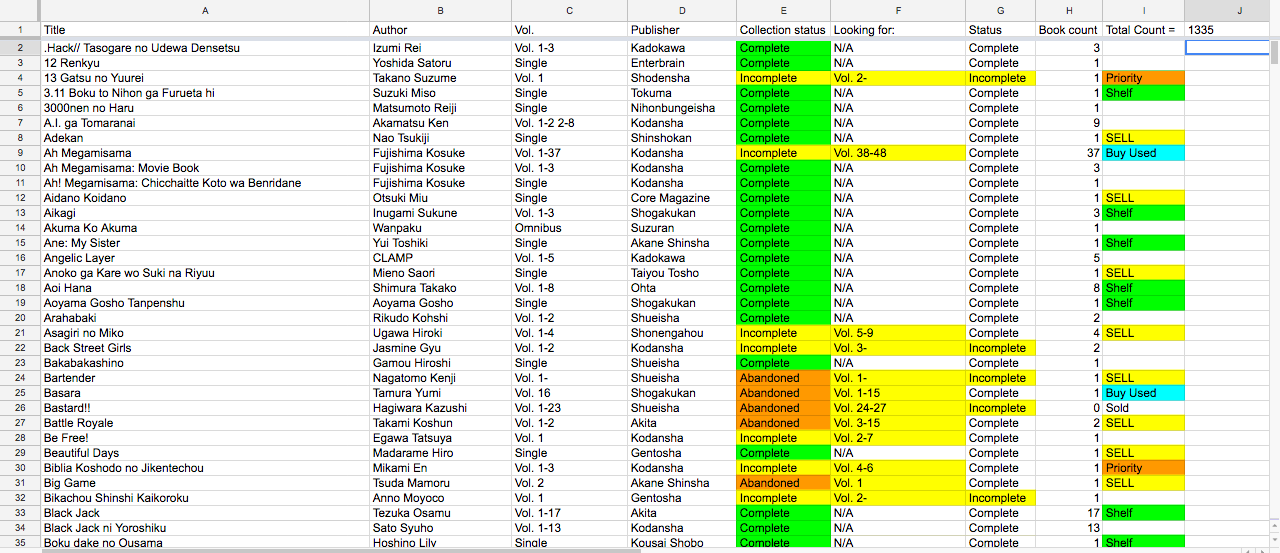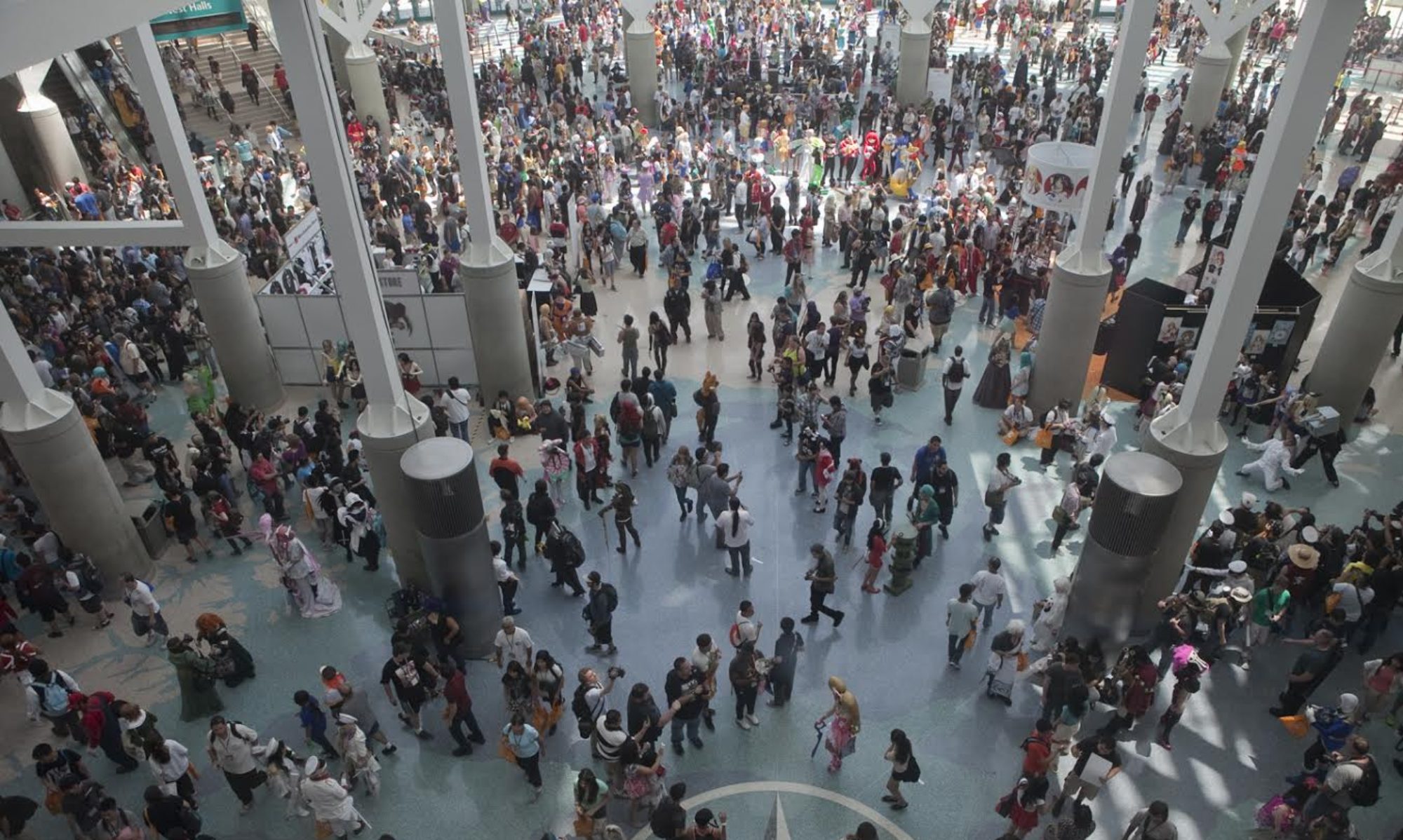Age: 29
Location: San Francisco Bay Area
When did you discover anime? I don’t have a specific memory of when I first discovered anime. I would guess that the first ever anime I ever did watch was something like Folktales from Japan back in the early ’90s. It was either that or watching a copy of My Neighbor Totoro on an Beta tape.
I will say I have a distinct memory of getting manga though, which was when I was 5=five years old. My dad dressed up as Santa Claus for a house party and gave me my first ever comic book, which was the first volume of Dragon Ball, but I know I was aware of manga and anime before then.
I still have the beta tapes and the manga, actually.
Really? Could I have a photo? Sure.

The first photo is of the requested Beta and Super8 tapes along with the first manga I ever read. Clockwise from top left, Sunset on Third Street: Song of the Sunset by Ryohei Saigan, Nonsense Company by Sansei Sato (these manga were my dad’s), Beta tapes of Moomin and Folktales from Japan, a 8mm video of My Neighbor Totoro (the other tapes I had weren’t anime), and the first four volumes of Dragon Ball. This would be what I would have been watching or reading around 1992-1995.

The second photo features what I would have been reading about 1995-2000ish when I started really getting into anime and manga. Clockwise from top left, I feature vol. 16 of Case Closed particularly because that was the first volume I ever bought (because I thought the cover looked cool); the first two volumes of Ah! My Goddess, which I instantly fell in love with the aesthetics; Evangelion, which I watched on PBS on Sundays in the San Francisco Bay Area; Slayers, which I think also aired on PBS; and the Pocket Monsters gag manga, which I read in elementary school because it was about the only age appropriate thing I was reading back then.
What appealed to you about anime when you first discovered it? For me, as a kid, it was entertainment. I grew up with the TV raising me for the most part. I liked anime because it was more fun than a lot of shows that were on TV. Growing up in America but in a Japanese speaking household, the tapes with anime and children’s programming tended to be a nice opportunity for me to enjoy something in Japanese so I was always on the lookout for that stuff.
What would you say was the most popular anime at the time? I remember going to Japan and seeing Dragon Ball Z‘s Cell saga was on TV? I remember this because I thought it was boring and I really wished I could watch something better… like City Hunter (which I caught reruns of). Sailor Moon was also on TV but that was for girls. (I know, right?)
What was it like to be a part of anime fandom at the time? I wasn’t really part of a fandom so much as I was taking part of my culture? I was the youngest person in my circle of Japanese expats living an hour east of San Francisco. The older kids had more manga than me and I would often go over to their place to read their collection. My parents typically only bought me one manga a year at the time, so I recall reading the same copy of the Pokemon gag comic over and over again.
Same with anime. I grew up really loving Ghibli movies because Nausicaa, Laputa, Porco Rosso, and Totoro were the only movies I had easy access to when I was really little.
You said, “I wasn’t really part of a fandom so much as I was taking part of my culture?” This is fascinating. What would you say is the difference between participating in anime fandom and participating in your heritage? I feel when anime and manga weren’t as popular in the United States, the charm for a lot of fans were how exotic the medium was. A lot of people said manga and anime were “different” or “more deep” than American works.
For me, though, it was more something I consumed because it was stuff I would have been reading and watching if I lived in Japan. I went to a Japanese hoshuko, a supplemental Saturday school for Japanese nationals living in America. My classmates and I lent each other manga and video games all the time. So this stuff wasn’t so exotic.
It actually felt a little jarring sometimes because I didn’t see myself as an “otaku” growing up. If anything, I was taught being an otaku isn’t something to brag about, so I often felt a little attacked when someone asked if I am one. When Hayao Miyazaki got the Berkeley Japan Prize in 2009, I was on assignment to cover the award ceremony for the English section of my paper. I was with another reporter from the Japanese section of the paper and she casually asked me, a pony-tailed guy covering an anime director, “so are you one of those anime otaku?” and I must have given the most distressed face she had ever seen because she immediately tried to console me that “otaku are totally hip these days.” (My long hair was more out of me being a closeted trans woman than being a nerd)
Was the Internet a part of fandom at the time? Again, at the time it was going over to my friends’ places and borrowing their comics. One friend had all of Dragon Ball, another had Dragon Quest and Slam Dunk.
I was actually not on the Internet until about 1998 and I didn’t really discover the “anime fandom” until I found those “web rings” and “shrines” people had for certain characters. I think I Yahoo searched for anime and eventually stumbled upon them.
God, wow, that actually happened.
I did become part of the American anime fandom after joining a webcomic forum back in 2003 or so? I’d peg that as my first time I really started talking to people and interacting with them over anime and manga.
On finding web rings and shrines, you wrote, “God, wow, that actually happened.” Could you elaborate? What was so weird and hard to believe about early web fandom? When you think about these characters that people made shrines for, you realize a lot of the shows they came from were only around for one or two seasons, yet they were powerful enough to get someone to make a website. Like, Outlaw Star aired for six months in Japan in 1998 and yet there I was 4-5 years later, finding myself at the cg shrines (http://ironmouse.za.org/dragon/index.html) to look at Aisha Clan Clan art.
I guess I feel it seems a little corny looking back at it too, and the fact I was into it myself is a thing I’m a little embarrassed to admit. Like, wow, people really liked these characters enough to put in the effort to make a website dedicated to them.
Do you remember your first convention? The first anime convention I ever went to was Fanime 2005. I went on Monday, the last day of the con and I wore a business suit to be a “random 4Kids henchman,” I pointed at people in lieu of having a gun. It was weird and Fanime was much smaller then. I saw some cosplayers, thought dealers hall was full of rare and amazing merchandise and most of the people there were incredibly thirsty.
“Thirsty.” Once again, could you elaborate? I do recall going to things like the yaoi bingo at the behest of friends. The annual tradition is run by YaoiCon and features things like two guys in lingerie giving each other lap dances on stage. I hear they’re still doing it now, but I feel it’s become less central to what I see promoted during the con. And then there was that “dating for otaku” panel featuring a panel of three women giving sex advice in lingerie. Overall, the late night programming was much more raunchy than what I hear about in recent years. I also felt there were more skeevy people back then in general. Personally, I’m kinda glad the culture of “glomping” has since fallen out of favor and that Fanime instituted “Cosplay is not Consent” policies like several other cons have done.
This might be partly because the con itself has grown to attract a larger, more general audience over the years, as well as my own change in how I spend my time at Fanime. (I lately spend my late nights at Fanime in my hotel room with friends instead of attending 18+ panels).
What was it like to meet American anime fans who are not Japanese? Was it weird? Did it feel like they were encroaching on your culture? I didn’t think they were encroaching on my culture. If anything, I feel excited and happy when someone says they enjoy something I thought was great or fun. I’ll still roll my eyes when someone tries to argue that anime as a medium is somehow philosophically or artistically superior to Western animation, but that perspective is no longer that popular.
If anything, when I was a freshman in high school, my school’s anime club (mostly run by white kids), introduced me to stuff like Trigun, Hellsing, Interstella 555, and Samurai X. I was grateful for that.
Even before that, I felt like I had some bragging rights when Pokemon became big in the late ’90s. I knew about the games, anime and manga a good year or two before it came to America.
What was the first fandom you got really invested in? How did you express your fandom? I’m more of a lone wolf and I have trouble getting excited about things with people. I can read about people giving effusive praise for a series and think, “oh, I want to read that series too,” but I have a hard time geeking out about things with other people.
The first fandom I did take part in is the Pokemon fandom. I played through Pokemon Red, Gold, Sapphire and Leaf Green versions religiously when they came out. With friends, I traded Pokemon cards, battled with them and spent time watching the anime when we went over to each others’ houses after school. Online, I got involved in writing fanfiction and chat role-plays around 2003 through 2006.
I started to drift away around the fourth generation of Pokemon because I didn’t own a Nintendo DS and the monster designs weren’t as appealing to me.
Did you stay a fan the whole time up until today? If yes, what kept your interest? If no, what got you back into anime again? I’d like to say I’ve been a fan without pause since I was little. I’ve never looked at anime as a medium and earnestly said “this is stupid.” I’ve also never quit collecting manga. I don’t recall if I mentioned in the initial response, but I have more than 1,300 volumes of manga, including 92 volumes of Case Closed. I’m still buying manga today, though my taste in what I read has radically changed over the years.
I will note, however, that I stopped watching anime after graduating college in 2010. I just didn’t have time to sit and watch shows and my work was taking me away from pop culture (I stopped watching American shows too so it’s not just anime). I kept active on Twitter to keep up with friends and I kept up with anime gossip there, but I actually didn’t watch anything except Lupin the Third: The Woman Called Fujiko Mine in 2012. I literally didn’t watch anything after that until around summer of 2016 when I saw a screen cap of Felix Argyle from Re:Zero. I then marathoned Re:Zero because I have a thing for gender-ambiguous characters and cat people. While I was on the Crunchyroll website, I figured I should check out some of the other shows and also watched Showa Genroku Rakugo Shinju too. Since then, I felt I should start watching more anime again.
Here’s a screencap of my inventory Google Sheet of my manga:

For you, what’s the biggest contrast between anime fandom then and anime fandom today? I think it’s the ubiquity of its aesthetics in America. For sure, it’s easier than ever to read and watch anime and manga in America, but I think what’s cooler is that it plays a huge role in media made in America.
For example, I watched Doraemon and Rocko’s Modern Life when I was little. Rocko is undeniably American and Doraemon is undeniably Japanese. Its setting, situations and aesthetics have almost no crossover whatsoever. Yet here we are in 2017, the kids that grew up watching Sailor Moon, Dragon Ball, Digimon, Tenchi Muyo, Gundam Wing are now making the cartoons kids watch on TV in America. Anime and manga is now an undeniable inspiration for Western cartoons and comics (https://www.youtube.com/watch?v=xvks9zNnNHc). So, I guess to put it another way, the anime fandom is much more broader and undeniably intertwined with mainstream American pop culture now.
Chiaki can be reached on Twitter.
